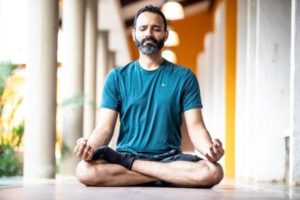Meditating for a whole hour is an achievable goal that offers both physical and mental health benefits. 20 minutes of meditation drastically changes the quality of your life, so what does an hour do? After an hour of meditation, it has been discovered that your nervous system slows down, bringing your whole body into a tranquil state. This can aid in a deeper sleep, decreased physical stress and lowered blood pressure.
Turning your short meditation sessions into a whole hour will take time, patience, and of course – practice. You may have already tried meditating for a whole hour and found you were unsuccessful. You might already have a good foundation in place for meditation and this guide will help you take it the rest of the way.
How to Meditate for an Hour?
- Don’t make meditation a ‘goal’
- Become an observer
- Improve your inhale/exhale process
- Find a way to increase time
- Use aromatherapy to increase focus
- Ditch the clock
- Incorporate yoga/stretching exercises
- Reevaluate your meditation space
- Practice mindfulness in other areas of your life
- Use a meditation app
- Go to a meditation retreat
Meditating for a Whole Hour
Below are 11 different ways that you can achieve meditating for a whole hour. You may find that you are successful after trying one of these methods, or you might have to combine several to achieve your ideal meditation length.
Even if you feel you are already doing some of these things, take the time to reevaluate your routine and determine what opportunities you might have for improvement in the following areas.
Don’t Make Meditation a “Goal”
If you go into your meditations with the idea that you must reach an hour, you are more likely to become frustrated and struggle with achieving it. When we create goals, our ego gets in the way and can distract us from the true purpose of meditation.
Instead, go into your meditations with the desire to reach a length of time in your meditation journey that helps you to feel connected with yourself and your mind. Focus on the quality of your focus and concentration rather than how much time you can sit for.
Become an Observer
As you sit in your meditation, you may find that your mind becomes busy or full of thoughts that have forced their way in. This is normal. Instead of fighting those thoughts, acknowledge that your attention has shifted from the sensation of your breath to the thoughts you are having.
Notice that.
And then without judgement or frustration (which is just another thought) return your focus to the sensation of your breath – focus on the place where you feel it the most with least amount of physical effort. Follow your breath but do not try to control it. Just let it happen naturally.
Focus.
Become an observer of your mind rather than allowing it to consume you. You may find it helpful to keep a meditation journal to write down your thoughts and struggles after each session. By writing these bothersome thoughts down it can aid in the process of healing and letting them go. Personally, I found it very helpful.
Improve your Inhale/Exhale Process
If you want to lengthen your meditation time, you can start by lengthening your breathing at first. Deeper breaths also have the added benefit of helping your body to relax and receive your meditation.
This is not by any means necessary for a meditation practice, but it sure can help some people struggling with keeping their focus on the sensations of each inhalation and exhalation. When I started out, I struggled a lot with that.
For some reason it was extremely difficult for me to actually “feel” the sensation of breathing. And taking deeper breaths has helped me do that.
With deeper breaths, the sensations are more pronounced and easier to experience. Therefore, easier to keep your continuous focus on.
Normally, one or two deep breaths at the start should do it.
Don’t overdo it! In some people, taking deep breaths might cause light headedness and dizziness, so be careful with that.
Find a Way to Increase Time That Works for You
You can extend your meditation time by adding a few minutes every few days to help your body and mind slowly acclimate to the new length, or you can add one longer meditation session once a week and continue to do so until all of your days are longer.
The important thing is to find what works best for you in the long term. Do not try to brut force it though. It’s easy to get frustrated with yourself and drop the practice all together because you think “it’s too hard” or “it doesn’t work”. It does!
That’s my favorite part about meditation — it doesn’t matter if you believe in the practice or not, it still works. I was skeptical until I saw the results firsthand.
Use Aromatherapy to Increase Focus
You may have added an aromatherapy option to your meditation space which could greatly improve your attempt at longer meditation. If your brain can focus on a scent and how it makes you feel, your brain will have less space to allow in outside thoughts that can distract your focus.
One of the easiest ways is of course to use a essential oil diffuser. They are cheap, effective and can make your room look cozy.
I use this one. (I’m not sponsored to promote it, and no affiliation of any kind – I just really love that diffuser. I bought two of them and used them for years, and they work great! You do need to buy essential oils separately.)
You can choose any scent that you find pleasant, but these are some of the top used scents in meditation:
- Lavender: this scent is used to calm the mind.
- Sage: is utilized for cleansing the mind and body
- Peppermint: a must-have for someone in need of mental focus
Ditch the Clock
When you are trying to meditate for a whole hour, often your brain will try to calculate how much time has passed in your meditation session or how much time is left. To help remove this unwelcome mental burden, add the use of a timer to your meditation sessions; you can set the time or have someone do it for you.
If you free your mind of the burden of trying to “guess” how much time you have left you will find the time goes by much faster, similar to losing yourself in a good book and letting half the day go by.
Incorporate Yoga/Stretching Exercises
As you know in meditation your body remains still for a long period of time. Even if you are a seasoned meditator, you may find that your body becomes sore and you must adjust your position.
Adding in daily exercises, such as yoga or stretching, can greatly affect your meditation time by helping your body to relax and open up to different positions, especially when you are sitting down.
These exercises don’t have to take up too much time and should be added prior to your meditation. If you are struggling to put together a routine, you can check out this YouTube video for a quick, 8-minute stretch that will have your body feeling ready to meditate!
Reevaluate Your Meditation Space
When creating your meditation space, there are many factors you might want to consider to help you improve the practice; how do you want the space to look? What do you want to feel when you enter your space? Are there elements you can have in your meditation area that can aid in your concentration?
All these factors you will want to take into consideration including a few more you may not have thought about:
- Feel Good Space: you do not want your meditation space to be in the middle of your children’s playroom or in the kitchen where everyone in your home is in and out of all day. Ideally, your space should be quiet and peaceful.
- Keep it Clean: just like our thoughts clutter our minds, things can clutter our meditation space. Your area should have only the necessities of your session such as a yoga mat, essential oil diffuser, mode to play music, etc.
- Comfort is Key: whether you chose to meditate on the floor, in a chair or on a bed, your meditation space should keep your body comfortable which will allow you to stay engaged in your session rather than focused on the discomfort of your body.
- Light: you can meditate by natural light, candlelight or in the darkness. It may take you a few tries before you find what works best for you.
- Bring in Nature: nature is thought to be healing and soothing, so finding a way to bring nature into your meditation space can boost results. It’s not always easily accessible, so your nature element could be as simple as a vase of fresh flowers or sounds of nature from a playlist.
- Make it Personal: Whether it’s a few tokens that you hold dear or simply décor choices, your meditation space should speak to you, about you. Anything that helps you get “in the zone” quicker.
Practice Mindfulness in other Areas of your Life
If meditation is the only time of day where you quiet your body and mind, meditating for a whole hour at once may be difficult to achieve. But meditation doesn’t have to be attached to a particular place or time.
With enough practice you will be able to meditate almost anywhere and anytime. Start small. Find a few minutes each day to remove yourself from the daily distractions and be present in the moment in front of you.
During a break at work you could sit on a bench outside and observe the things around you: the color of the sky, the texture and the temperature of the bench, or the pressure it applies to your butt and your back; the ambient noise, birds singing, people, cars driving by.
The key is to focus on the sensations. And each time your attention shifts, gently return it back without judgement. Keep practicing.
Nowadays, this is one of my favorite types of meditation as it can drastically improve your day.
Also, it helps to remove unnecessary distractions such as cell phones from this exercise.
Use a Meditation App
If you find that after these steps you are still struggling, you can turn to the help of a meditation app. They can offer guided meditations, soothing sounds or music for your session or other health tips that could improve the duration and quality of your practice.
If you followed me for a while, you know I am a huge fan of using guided meditation apps. They have taught me so much.
My favorite meditation Apps (not sponsored or affiliated in any way) that I’ve personally used for many years are:
Waking Up: Sam Harris offers an amazing approach to mindfulness meditation. The App includes lessons and conversations with famous meditation teachers that will help to guide you through on your journey. This App is amazing!
Calm: Hosts calming exercises, breathing techniques and even a “Sleep Stories” section (that I love!) led by famous actors like Matthew McConaughey to help you improve your sleep. I love this App, it helped me a lot with improving my social anxiety.
10% Happier: Features one of the most amazing and respected meditation teachers on the planet – Joseph Goldstein. The app has tons of lessons and conversation that will provide a great insight into the practice making it much easier for you to improve.
Two of the best things I’ve learned using the Apps is “how to do meditate while walking” on the street, and “how to meditate with open eyes”, including crowded and noisy places like gyms, parks, coffee shops.
I cannot recommend them enough! I checked out Free and trial versions first, and found the App “Calm” to be particularly good, and it’s limited content to be easily repeatable. I think it is a great place to start.
If you can only afford one of the Apps, I would highly suggest the Waking Up APP as I think it’s the best meditation App there is. Also because of this. If you can’t afford the subscription, you can email their customer support and they will give you full access to the App for free. Stellar customer service!
Go on a Retreat
In some cases, total submersion may be what you need to achieve meditating for a whole hour. Retreats can last for a few days, a few months or even a year if you have the desire.
Eliminating every distraction from life and being able to focus solely on your meditation journey can help you to achieve your meditation goals in a shorter amount of time.
I have not been on any of retreats listed below! These are just some of the places I have found on the internet to help you choose if you don’t know where to start. Do a proper research before selecting the place, to ensure that what they provide matches your needs and expectations.
Depending on where you live there may be many options to choose from or very few; however, there are a few meditation retreats that stand out above the rest:
Ananda in the Himalayas: this 100-acre retreat in India offers tailored one-on-one meditations sessions, a 21,000 square-foot-spa and yoga pavilions spread throughout the property.
Spirit Rock Meditation Center: located in California, Spirit Rock sits upon lands used for spiritual rites for Native Americans. Here you can do full-day meditations as well as a two-month meditation or residential retreats.
Shambhala Mountain Center: this 600-acre retreat in the Rocky Mountains offers personal retreat packages as well as variety of programs that can be attended for a day, a week or up to a month. If you choose to stay for more than one day, you can camp out in a tent and submerge yourself in nature or stay in a modern suite.
Rolling Meadows: located in Maine, Rolling Meadows offers silent meditations and yoga retreats. Their focus is on reflection, solitude and enjoying the beauty of the land.
Kalyana Centre for Mindfulness: mindful meditation is the aim at this Ireland retreat. Tibetan healing yoga is woven through the practice and much of the retreats are conducted in silence.
Guided vs. Unguided Meditation
As you pursue meditation for a whole hour you may ask yourself if one style of meditation is more effective than another.
In meditation there are two different styles you can choose from:
- Unguided meditation
- Guided meditation
As a beginner I think it could be helpful to start with guided meditation to give you a sense of direction on where to start your journey and now that you are more experienced feel you can move to unguided if you haven’t already. But what is the difference between these two styles?
Unguided Meditation: as the name suggests, unguided meditation puts you in the driver seat, selecting the time of day, length of time and focus of your meditation sessions.
You are responsible for creating your meditation space, choosing what type of meditation you would like to pursue and what you would like to visualize during that session. This also means you alone oversee the process and determine what progress you make with your meditation which may prove difficult even for the seasoned meditator.
Guided Meditation: is useful for beginners who may not know how to begin meditating or find they have trouble concentrating on the act of meditating without letting their thoughts overrun their session.
Guided meditation can also be useful to experienced meditators who feed off the energy of others or have been looking for new inspiration in their own silent meditations. In addition to this, guided meditation gives the power over to someone else, allowing them to worry about the structure of the meditation time, so you can focus solely on yourself.
So Which Method is Better?
What you need to keep in mind is the most successful meditation is the one you perform with consistency.
However, in the long term I think silent meditation could be better of the two methods because meditation is not supposed to be easy, and the challenges it presents can become the most beneficial to your meditation journey.
If you started out meditating solo but find that you cannot commit to longer times without being guided, then be sure to listen to what you need and pursue that.
Like me, you may also find that you benefit from both types of meditation and must find a way to incorporate them both into your routine. Whichever path you take, prioritize consistency above all else.
Types of Meditation
At last I wanted to mention that if all methods fail you and you still struggle to get close to that one hour of meditation time, it can be helpful to change things up and try a different type of meditation.
There are 6 main types of meditation, all with a different focus or goal to their participants.
Mindfulness: originated from Buddhist teachings; combining concentration and awareness, mindfulness is about recognizing your thoughts as they enter your brain without judgement or involvement.
Spiritual: used in Eastern religions, to gain a deeper connection with the Universe, or your god .
Focused: concentrates on using the five senses to focus your attention, such as staring at a candle, observing your breathing or listening to sounds/music.
Movement: letting gentle activities guide you such as yoga, hiking, gardening to let your mind wander.
Mantra: provides deep levels of awareness through the repetition of a word or phrase, such as “om” to clear the mind. Traditionally seen in Hindu and Buddhist traditions.
Transcendental: for more serious meditators who like structure; customizable in the use of mantra or series of words specific to each meditator.
Meditation was Made for You
If you have been meditating for some time utilizing one of those types of meditation, you may wish to step out of your comfort zone and try another. You may start with one type of meditation but find yourself drawn to another. Or, you could prefer utilizing multiple meditation techniques depending on your needs.
I have to mention, that practicing several types of meditation before having mastered one is not something I would recommend to everyone.
Mainly because meditation is a difficult skill that takes hard work, a lot of time and commitment to master. Trying to get good at several types of meditation at the same time is not practical. It will take time before you can see any results.
Meditation is not a quick fix. It can take a while to achieve the level of mastery necessary to yield great results.
At the beginning trying to learn two different types of meditation with all the nuances and complexities and not seeing feasible results — you are increasing the risk to burn out before you ever really get a chance to succeed.
Meditation is not one size fits all. It takes time, patience and a lot of practice to find your perfect meditation routine and it is not something that should be rushed through.
It maybe a good idea to try and experiment at the beginning to see what type suits you, but eventually do pick one, and go all in on that.
Listen to your body and adapt to what it needs as you progress. Meditation is a great way to gain mental clarity, physical calm and peace. You just need the desire and be consistent to pursue it.



